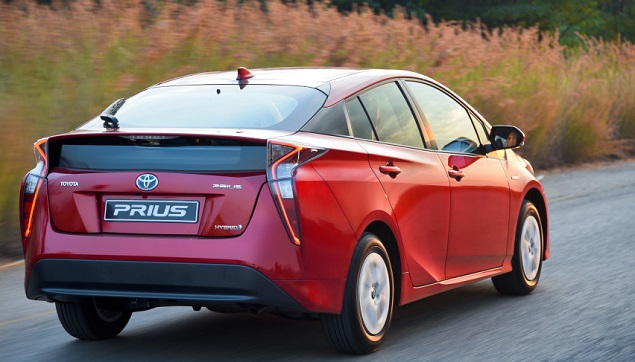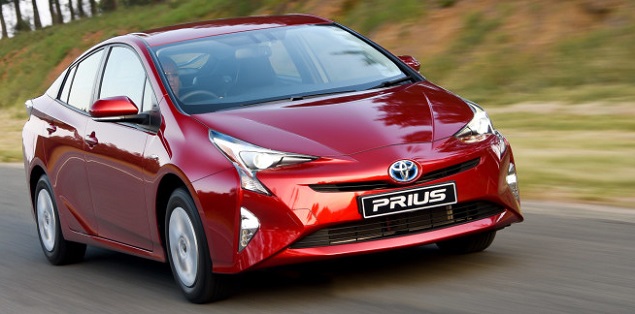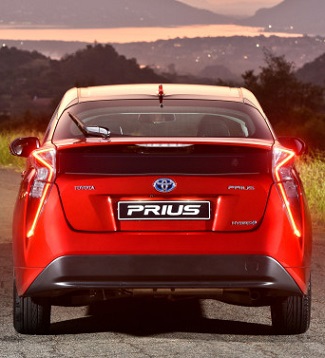- Sleeker, more fuel-efficient, better cabin
- High-tech facia and windscreen head-up display
- Fourth generation, third for SA since 2005

The latest version of Toyota’s Prius petrol/battery hybrid car, first seen in South Africa way back in 2005. is now in South African showrooms.
The first units only reached SA when the second generation was launched and that was eight years after the first units went on sale elsewhere around the world.
The car claims to be the first mass-production ‘green car’ and this the latest version the fourth generation, will add to the more than 3.5-million already on the roads.

Glenn Crompton, Toyota SA’s vice-president for marketing, told The Corner in a media release: “The fourth-generation Prius builds on the strengths and achievements of its predecessors and establishes benchmarks in fuel economy, clean emissions and efficiency.
“It will add impetus to the growing appeal of hybrids in the global market with its strongest-yet environmental performance, much-improved styling and surprising driving dynamics.”
Toyota says the new Prius also embraces stronger emotional and performance qualities for “wider and greater appeal with eye-catching and original styling and high levels of sensory quality and practicality”.
Also new, we’re told, are the cars’ hybrid drivetrain and chassis, the latter based on ‘Toyota New Global Architecture’ on which will ride other future Toyota products “from compact sports cars to SUVs”.
The body is 60% more rigid than before thanks to extensive use of high-strength steels and reinforcement to the centre pillars. “The result,” Toyota says, “is superior, direct and responsive handling – especially on uneven roads.”

The automaker claims “outstanding stability”, especially on winding roads. “The new car has a lower centre of gravity and,” we are told, “a more attractive and lower bonnet, which in turn improves safety by giving the driver a clearer forward view.”
Certainly the new car is more attractive than its predecessor’s almost minibus appearance. Its chief designer Shunsaku Kodama says the focus was “to inject ego into the car by crafting a more powerful, engaging and sporty image that would increase pride of ownership beyond Prius’s traditional ethical profile”.
The lower part of the front bumper, lower grille and the wheel arches are intended to direct airflow around and under the vehicle; a shutter behind the lower grille opens and closes according to engine-cooling requirements.

The car’s profile is looks much lower than the previous model, though in fact the difference is only 15mm, to 1.48m. The wheelbase remains at 2.7m though the car is 60cm longer at 4.54m; the proportions, along with the aero treatment for the roof, add to the sleeker appearance.
Other aerodynamic aids, Toyota says, are vertical channels each side of the windscreen to direct airflow and rain over the roof and stabilising fins on the quarter-lights. The drag coefficient is only 0.24.
The cabin claims to be “futuristic and stylish, yet rational and ingenious” with multi-function displays; the overall effect a lighter, more pleasant, atmosphere accentuated by the facia being further than usual from the driver.
The 19cm touchscreen looks like a tablet computer and has similar “flick” operation to scroll through displays, including that of the six-speaker audio package.
The instrument cluster is an 11cm TFT display for fuel level, odometer, trip meter, driving range, average fuel consumption, outside temperature and drive mode.

“Overall,” Toyota says, “the new Prius provides a cabin environment that exudes a genuine sense of luxury with exceptionally low noise and vibration.”
Standard are a a rear camera, seven crash bags, customisable dual multi-information display screens, and heating for the front seats. The car also has a colour head-up display for the windscreen.
Of course the heart of the car is its new hybrid drive. Toyota says it has focused on making it “even easier and more intuitive to drive”.
Fuel economy has been improved with advances in battery, electric motor and petrol engine technology. The battery pack is 10% smaller and is faster to recharge. The electric motors are smaller and the thermal efficiency of the petrol engine has been improved by 40% to, the automaker claims, “become a world’s best for a petrol unit”.
The Prius engine is still a 1.8-litre VVT-i Atkinson cycle unit but has been completely re-engineered for fuel economy. The gas flow, combustion, cooling and knock control have all been improved, Toyota says, “and much more effective use is made of exhaust gas recirculation” with a heat recovery system that uses exhaust gas to help get the engine coolant to operating temperature.
The intake and exhaust systems were also revised, resulting in an engine whose modest 72kW is delivered at 5200rpm. Peak torque is 142Nm at 3600rpm.

The two electric motors double as starters for the petrol engine; they are also the only drive in reverse gear and their efficiency as further reduced the requirement to use the petrol engine – particularly at higher speeds.
The nickel-metal hydride battery is more compact and is located entirely beneath the rear seats.
All the above, Toyota says, has meant the fourth generation is the greatest yet. “Every aspect of the hybrid system has been made more efficient, delivering about half the gain in fuel-efficiency. The petrol engine uses less fuel; the electric motor-generators are smaller, lighter and more efficient; mechanical losses in the transaxle have been cut by 20%; the power control unit is more efficient; the HV battery is lighter and more efficient.
“Further gains have been made by reducing the energy load of the aircon, reducing the tyres’ rolling resistance and creating a more aerodynamic vehicle.”
THREE DRIVE MODES, 10.6 TO 100
The new Prius accelerates to 100km/h in 10.6sec, 80-120km/h requires 8.3sec and top speed is 180km/h with petrol and electric power engaged and delivering a combined 90kW.
There are three drive modes – Normal, ECO, Power – and pure electric mode can be used for short distances. Battery-power commuting, for instance, is not possible with the Prius – regard the electric power as anciliary, much as it is in Formula 1 cars
Fuel consumption is listed as 3.7 litres/100km.
Prices for the new Prius start at R427 200, including a five-year or 90 000km service plan. Standard warranty is three years or 100 000km (not great given the new industry best is seven years from Hyundai) though the battery pack is guaranteed for eight years or 195 000km.

